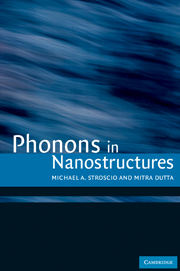Book contents
- Frontmatter
- Contents
- Preface
- Chapter 1 Phonons in nanostructures
- Chapter 2 Phonons in bulk cubic crystals
- Chapter 3 Phonons in bulk würtzite crystal
- Chapter 4 Raman properties of bulk phonons
- Chapter 5 Occupation number representation
- Chapter 6 Anharmonic coupling of phonons
- Chapter 7 Continuum models for phonons
- Chapter 8 Carrier–LO-phonon scattering
- Chapter 9 Carrier–acoustic-phonon scattering
- Chapter 10 Recent developments
- Chapter 11 Concluding considerations
- Appendices
- References
- Index
Chapter 3 - Phonons in bulk würtzite crystal
Published online by Cambridge University Press: 09 October 2009
- Frontmatter
- Contents
- Preface
- Chapter 1 Phonons in nanostructures
- Chapter 2 Phonons in bulk cubic crystals
- Chapter 3 Phonons in bulk würtzite crystal
- Chapter 4 Raman properties of bulk phonons
- Chapter 5 Occupation number representation
- Chapter 6 Anharmonic coupling of phonons
- Chapter 7 Continuum models for phonons
- Chapter 8 Carrier–LO-phonon scattering
- Chapter 9 Carrier–acoustic-phonon scattering
- Chapter 10 Recent developments
- Chapter 11 Concluding considerations
- Appendices
- References
- Index
Summary
Next when I cast mine eyes and see that brave vibration, each way free; O how that glittering taketh me.
Robert Herrick, 1648Basic properties of phonons in würtzite structure
The GaA1N-based semiconductor structures are of great interest in the electronics and optoelectronics communities because they possess large electronic bandgaps suitable for fabricating semiconductor lasers with wavelengths in the blue and ultraviolet as well as electronic devices designed to work at elevated operating temperatures. These III-V nitrides occur in both zincblende and würtzite structures. In this chapter, the würtzite structures will be considered rather than the zincblende structures, since the treatment of the phonons in these würtzite structures is more complicated than for the zincblendes. Throughout the remainder of this book, phonon effects in nanostructures will be considered for both the zincblendes and würtzites. This chapter focuses on the basic properties of phonons in bulk würtzite structures as a foundation for subsequent discussions on phonons in würtzite nanostructures.
The crystalline structure of a würtzite material is depicted in Figure 3.1. As in the zincblendes, the bonding is tetrahedral. The würtzite structure may be generated from the zincblende structure by rotating adjacent tetrahedra about their common bonding axis by an angle of 60 degrees with respect to each other. As illustrated in Figure 3.1, würtzite structures have four atoms per unit cell.
The total number of normal vibrational modes for a unit cell with s atoms in the basis is 3s. As for cubic materials, in the long-wavelength limit there are three acoustic modes, one longitudinal and two transverse. Thus, the total number of optical modes in the long-wavelength limit is 3s – 3.
- Type
- Chapter
- Information
- Phonons in Nanostructures , pp. 16 - 25Publisher: Cambridge University PressPrint publication year: 2001
- 2
- Cited by

